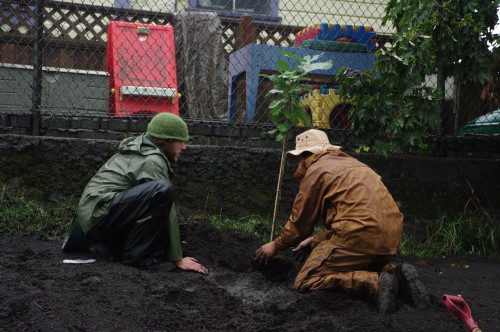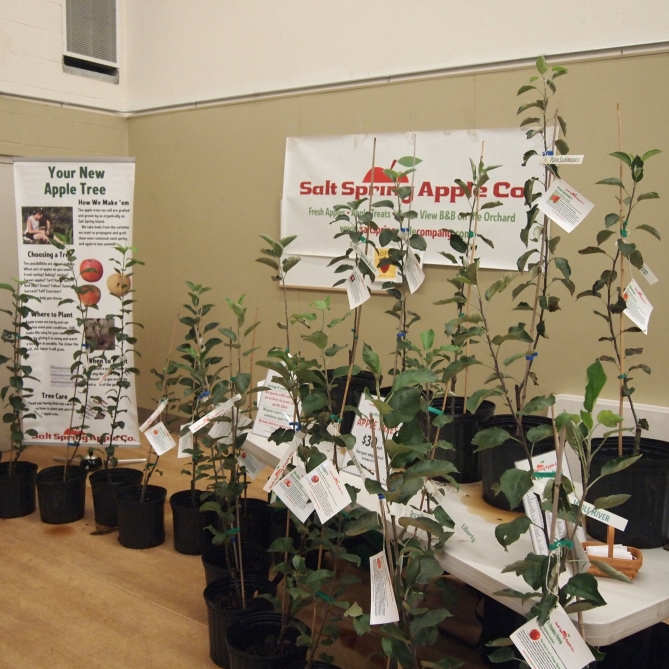>> Margaret Hantiuk
Choosing your trees
Do research and buy from reputable nurseries. Pick trees that suit your locale, your needs and taste and finally, your site. Consider dwarf, semi-dwarf or full size fruit trees. Look for specimens that are healthy and varieties that are disease-resistant. A good nursery will carry the best cultivars for this area. Some fruit trees are grafted onto a different rootstock for added vigour—make sure the graft union is healthy. Check if you need more than one tree for pollination. This is not a concern if there are similar fruit trees nearby. Encouraging native bees and growing flowers that attract bees will improve fruit yields; try a ‘mason bee’ workshop at the Compost Education Centre.
Planting

It’s best to plant fruit trees in the late fall or early spring before bud break; choose a sunny spot with lots of room for air circulation. The soil should drain well. If it doesn’t, the planting hole can be amended with 1/3 compost. The hole should be about three times the size of the root ball in width and as deep as the root ball. Firmly pack the soil to exactly the same level at the trunk ‘flare’ and if there is a graft union it must be above soil. Remove all burlap, wire, or twine. The roots should be teased out or scored if root-bound.
If you are planting more than three trees, it is wise to have a soil test. You can get your soil tested at Integrity Sales on Keating Cross Road. Staking young trees is unnecessary except in exposed, windy sites. If staking is needed, pound two heavy stakes across from each other into the undisturbed soil and use ‘Harbour Tie’—a webbed, biodegradable material that will not injure the tree. Stakes should be checked after storms to ensure they are intact. Remove stakes after two or three years as they can maim a tree as it grows.
Apply a two to three inch mulch of compost and/or wood chips—not cedar or walnut—around the tree to the drip line annually. Make sure the mulch does not touch the base of the truck as it will rot and eventually kill the tree.
Care of your fruit trees
Every species has different needs and growing habits. Keep your tree watered the first two seasons and in droughts thereafter. Trees planted against a south-facing wall, under eaves, or in containers may need more watering. Many fruit trees don’t like to be over-watered and generally occasional deep watering is better than frequent shallow watering. Good drainage is necessary in our wet winters. Most fruit trees need no fertilizing other than an annual thick mulch of compost. Clean up dropped fruit to prevent harbouring insects. If bugs, birds, or animals get your fruit before you do, consider netting your tree or purchasing the small cloth bags that are tied over the fruit clusters or fruiting branches while they ripen. Russell Nursery on Wain Road sells these products. If pruned properly and with good care, a fruit tree in a good spot can naturally resist disease.
Pruning your fruit trees
Check to see if your fruit tree sets fruit on new wood or previous season’s wood. It is important to know that every pruning cut is crucial, especially with young trees, and will impact the fruiting.
Tools needed:
- Good seccateurs (Felcro #2 is the best), small pruning saw, loppers, pole pruners—all kept sharp and cleaned occasionally with Lysol
- Bonsai wire, twine, ‘Harbour Tie’ or Velcro ties
First, the old rule applies here: always prune for the 3 D’s: dead, diseased, and damaged wood is removed to the source. Learn to make a proper pruning cut: just up to the ‘collar’ of the originating branch—don’t leave stubs. Otherwise, the general rule of thumb for fruit trees is: prune to downward and outward facing buds and branches and prune off all upward and inward facing buds and branches. The aim is to create an umbrella shaped tree that is not too high, for fruit accessibility, and one that has space in the interior to allow sunlight and air in, to discourage disease.
Never prune too much in one year, as a stress response will be triggered. Suckers or water shoots are the result. These shoots don’t fruit and will rob the tree of its vigour. The less cuts the better unless you are pruning for the ‘espalier’ or ‘cordon’ styles of growing, which means alongside a wall or fence, that requires constant pruning the first few years.
Pruning should be done in late winter before the sap rises—water shoots can be removed anytime. Bonsai wire may be used to train young branches to grow more horizontally instead of cutting them. The fewer wounds the better as each wound is a potential entry for disease or bug infestation. Bonsai wire is wound around the young branch in the spring and is removed at the end of the season. In days past, small rocks or weights were tied to young limbs to train them to not grow up. The leader can also be weighted or bent once it has reached the desired height. When branches point downward their vigour is slowed and more energy goes into the fruiting.
There are two kinds of ‘buds’ on fruit trees: the flower/fruiting spurs and the leaf bud. The flower/fruit spur is thick and knobby while leaf buds are usually smooth and pointy. Good pruning encourages as much fruiting spurs as possible: ‘hands’ or clusters of fruit spurs along the branches are ideal. Leaf buds are also needed as the leaves feed the tree.
With restoration pruning, have a five-year plan. Remove no more than twenty-five percent each year, slowly bringing the tree back to a healthy size and better ‘scaffolding’ for fruit production and access. Fruit can be thinned in early summer if a branch is too loaded.
Recommended pruning book: American Horticultural Society Pruning and Training by Christopher Brickell & David Joyce
Local fruit tree nurseries:
- Salt Spring Apple Company, 529 Fulford-Ganges Road, Salt Spring Island, 250-537-4935
- Fruit Trees and More (Bob and Verna Duncan), 724 Wain Road, North Saanich, 250-656-4269
- Le Coteau Nursery, 304 Walton Place, Saanich, 250-658-5888







Leave A Comment